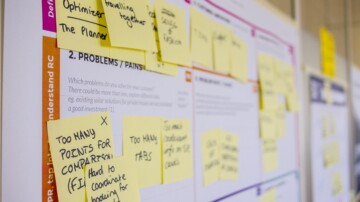5 Ways Grantmakers Create Work- and Tech-Life Balance

You’re on a mission to make a difference in your community through grantmaking. But you’re two years into a pandemic many of us thought would be over in two weeks. If you’ve found yourself wishing things could go back to “normal,” you’re in good company.
The world has changed. And so has the way we live and work. Given this new reality, how do you stay focused on your mission while also creating tech-life and work-life balance?
Unfortunately, you can’t wave a magic wand to make things go back to the way they were pre-pandemic. But there are five simple things you can do right now to be more productive and find more balance in today’s changing world.
1. Create a start and stop routine (and add it to your calendar.)
The pandemic has blurred the lines between our professional and personal lives. In fact, too many of us are up checking emails, responding to text messages, scrolling through social media, and going through our mental checklists before we even roll out of bed.
This is a classic example of Intention Deficit Disorder (IDD) or being busy without a clear purpose or outcome in mind.
You spend your days in back-to-back meetings and sitting behind a screen all day.
But you’re not a robot. You need time to rest, recharge, and recover. This is one of your most powerful productivity tools.
You can break this pattern by identifying a start and stop ritual to bookend your workday. The start ritual is something you do for yourself (e.g., having a cup of tea, walking the dog, or doing yoga) before jumping into your work.
Similarly, the stop ritual (e.g., putting away your work computer, starting dinner, etc.) provides a clear boundary and helps you transition out of your workday.
If your time is limited, consider starting with just five minutes for yourself at the start and end of the day.
2. Have shorter meetings.
If you feel like the number of meetings has increased during the pandemic, you’re not imagining things. A recent study conducted by Harvard Business School shows that meetings have increased, and we’re working longer and harder than ever before.
But it doesn’t have to be this way. Consider meetings as a last resort. And if you determine a meeting is absolutely necessary, have speedier meetings by changing your calendar settings to shorten the default length of your meetings by 5 – 10 minutes.
So, if you have 30-minute meetings as your default, your calendar will block 20 minutes or 25 minutes instead.
This gives you and your team a buffer so you’re not rushing directly from one thing to the next.
3. Schedule focus time.
One consequence of more meetings is longer workdays and less time to do the work generated by all the meetings.
One way to address this challenge is to proactively block out time on your calendar for non-meeting activities (e.g., reviewing grant proposals, writing RFPs, etc.).
Scheduling meetings is second nature for many of us. But it’s more challenging to create the space we need to get meaningful work done.
Once you’ve established your focus blocks, using a productivity strategy such as the Pomodoro method can be a powerful way to make progress, especially when you have a hard time concentrating for long stretches of time or you’re frequently interrupted. This approach allows you to do short, focused work sessions with frequent breaks.
4. Establish your rules of engagement.
Prolonged uncertainty brought on by the pandemic has been complicated by the fact that many of us are accustomed to operating based on unwritten assumptions about when we need to be available for work, especially while working remotely.
The truth is hybrid and remote work are still work. And working remotely doesn’t mean you suddenly have more hours in the day.
We can address these assumptions by having explicit ongoing conversations with our teams that address key questions such as:
- Which hours will you be available for work each day?
- Which hours will you be available for life outside of work?
- Which tools should colleagues use to reach you for urgent matters? What about non-urgent issues?
- What’s an urgent matter?
- How soon should someone expect a response from you depending on the level of urgency?
Establishing and communicating these boundaries removes the guesswork around when and how you are available for your work and personal life and reduces any anxiety you may feel about needing to be on and available 24/7.
5. Be compassionate with yourself and others.
Creating balance is an ongoing process of aligning (and re-aligning) your time, talent, energy, and resources vs. a one-time flip of the switch.
It’s also an ongoing practice that shifts with the seasons of your life and work. Life doesn’t stand still. So, it stands to reason that balance isn’t a destination you arrive at someday.
Finally, if you’re struggling with juggling all the things on your plate, take a moment to pause and know there’s nothing wrong with you.
Celebrate that you’re doing the best you can with what you have right where you are. And that’s all anyone can ask of you.
How are you holding up during the pandemic? Let us know by completing this brief survey. Seriously, we’d love to hear from you!
Want more tips for finding balance in today’s changing world? Join our upcoming webinar on Creating and Sustaining a Culture of Wellbeing for Grantmakers.



